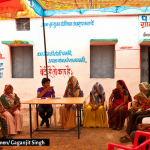
A Dismal Picture of Fiscal Fragmentation in Tumakuru, Karnataka
4 June 2021
This blog is part of a series unpacking the ‘PAISA for Municipalities‘ research which analysed urban local body finances in Tumakuru Smart City of Karnataka. The first part offers why the study was conducted, the backdrop to the study, and the researchers involved. It can be found here.
In my previous blog, I had described the system in Karnataka for devolution of funds to rural local governments. This comprises an Annexe to the State budget named the ‘Link Book’, in which all allocations made to rural local governments are listed out. When last estimated, they accounted for about 17 per cent of the state budget. These funds are separately sent to the local governments directly by the Finance Department without recourse to the line departments concerned.
There are several imperfections with respect to the Link Book system:
- First, the allocations are done scheme-wise and grants are not flexible.
- Second, they break down the allocations to the district level, though recently steps have been taken to further break these allocations down to the Taluk and village Panchayat levels.
- Third, over time, schemes that ought to be financially devolved to the local governments in accordance with functional devolution have been spirited away by line departments and centralised. The mismatch, if corrected, could increase the allocations in the Link Book by about 10 per cent more, raising the percentage of fiscal devolution to about 27 per cent from the current 17 per cent of the budget.
On the urban side, the practice of having a Link Book is a recent one. Here too the Link Book listed out allocations made to Municipalities and Corporations, and did not carve out and state the allocations that are spent by the multitude of parastatals that operate in urban areas.
As part of our research tracking urban local body finances in Tumakuru Smart City, we discovered that the overall devolution of funds to urban local governments hovers from 4.5 per cent to 5 per cent every year. In the context of India’s fast urbanisation, and the urban growth in Karnataka, the state’s urban local governments are hamstrung in providing services to urban citizens.
Clearly, the state does not provide adequate fiscal devolution to urban local governments to meaningfully manage urban service delivery and urban growth. Instead, parastatals and parallel bodies operate at a significant scale in urban centres.
Our study showed that the list of schemes contained in the Link Book for urban areas remained largely unchanged from 2011-12 to 2017-18, as follows. (Table below)

However, from 2015-16 onward, both JNNURM and NULM were no longer contained in the urban link document.
What is more disappointing, is that in the budgets of FY 2018-19 and thence, the practice of having a link document for urban local governments was dropped altogether. Clearly, the institutional mechanism for an inter-governmental fiscal transfer system for urban local governments, had imploded.
Whilst keeping this regression in mind, the question is whether line departments and parastatals had any system for displaying their budgets district wise or local government wise.
If that is done, even in the absence of a Link Book, one would be able to assemble together the allocations of funds that are spent within the jurisdiction of a local government. However, there too we hit a wall.
We discovered, therefore, that answering the simple question that we had set for ourselves – namely, the extent of expenditure by various entities on a ward wise basis within Tumakuru City Corporation, would be well-nigh impossible.
Finally, we had to turn to the Zilla Panchayats (ZP) to seek our information. Many of these line departments fall under the control and supervision of the Zilla Panchayat, even though they deliver public services in urban areas through their public service institutions. For instance, the Education, Women and Child Welfare, Social Welfare and Backward Classes and Minorities district offices, which are all under the control and supervision of the Tumakuru ZP and Taluk Panchayats, deliver services within the city.
So, we turned our faces in the direction of the rural local governments of Tumkauru, to discover their expenditures in the urban areas of Tumakuru! What a paradox!
T.R. Raghunandan is an Advisor at Accountability Initiative.





